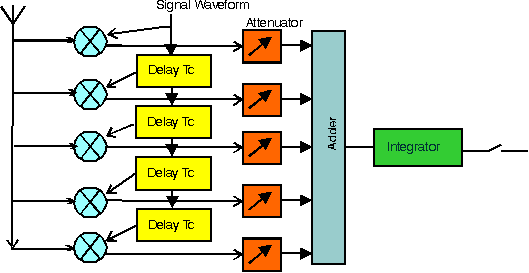
 |
JPL's Wireless Communication Reference WebsiteChapter:
Analog and Digital Transmission
|
If, in a mobile radio channel reflected waves arrive with small relative time delays, self interference occurs. Direct Sequence (DS) Spread Spectrum is often claimed to have particular properties that makes it less vulnerable to multipath reception. In particular, the rake receiver architecture allows an optimal combining of energy received over paths with different. It avoids wave cancellation (fades) if delayed paths arrive with phase differences and appropriately weighs signals coming in with different signal-to-noise ratios.
The rake receiver consists of multiple correlators, in which the receive signal is multiplied by time-shifted versions of a locally generated code sequence. The intention is to separate signals such that each finger only sees signals coming in over a single (resolvable) path. The spreading code is chosen to have a very small autocorrelation value for any nonzero time offset. This avoids crosstalk between fingers.In practice, the situation is less ideal. It is not the full periodic autocorrelation that determines the crosstalk between signals in different fingers, but rather two partial correlations, with contributions from two consecutive bits or symbols. It has been attempted to find sequences that have satisfactory partial correlation values, but the crosstalk due to partial (non-periodic) correlations remains substantially more difficult to reduce than the effects of periodic correlations.
The rake receiver is designed to optimally detected a DS-CDMA signal transmitted over a dispersive multipath channel. It is an extension of the concept of the matched filter.

Figure: Matched filter receiver for AWGN channel.
In the matched filter receiver, the signal is correlated with a locally generated copy of the signal waveform. If, however, the signal is distorted by the channel, the receiver should correlate the incoming signal by a copy of the expected received signal, rather than by a copy of transmitted waveform. Thus the receiver should estimate the delay profile of channel, and adapt its locally generated copy according to this estimate.
In a multipath channel, delayed reflections interfere with the direct signal. However, a DS-CDMA signal suffering from multipath dispersion can be detected by a rake receiver. This receiver optimally combines signals received over multiple paths.

Figure: Rake receiver with 5 fingers
Like a garden rake, the rake receiver gathers the energy received over the various delayed propagation paths. According to the maximum ratio combining principle, the SNR at the output is the sum of the SNRs in the individual branches, provided that
 | Different reflected waves arrive with different delays. A rake receiver can detect these different signals separately. These signals are then combined, using the diversity technique called maximum ratio combining. |


 A
spread spectrum receiver with rake outperforms
a simple receiver with a single correlator.
A
spread spectrum receiver with rake outperforms
a simple receiver with a single correlator.

 The Number of Resolvable Paths
The Number of Resolvable Paths
Tmax
L = round(------) + 1
Tchip
where Tmax is the maximum delay spread of the multipath channel.
The infopad research project implemented a broadband CDMA system for downlink transmission, with a monolithic radio receiver. The rake filtering is done at base band.
 Novel receivers
for CDMA
Novel receivers
for CDMAAn overview of various techniques by Ahmet Tewfik: MP3 files: 1, 2, 3
Array Processing for CDMA by Peter Grant: html
Multiuser Detection by Sergio Verdu: Real-Audio